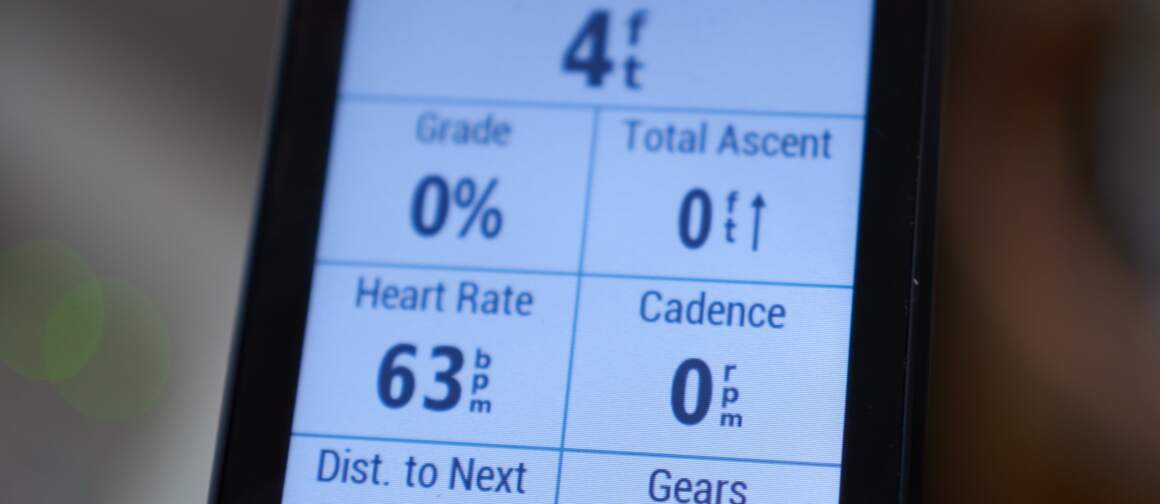
Editor’s Note: This article was updated on 9/3/2021 to reflect some of the experiences we’ve had since the review came out, as well as reflect some of the conversations we’ve had with the PR and product teams. Notably we have added to our thoughts about mapping and navigating on the Garmin Edge, and added a section on the company’s Tacx bike trainers and the tight integration with the Garmin head units.
Garmin Edge 1030 Plus: Garmin’s most powerful bike computer ever is a gem in an era of newfound competition—is it enough to hold off the challengers?
In the beginning, there was the bike computer. Small of screen and bereft of features, the typical bike computer was less powerful than the average Casio digital wristwatch. Feeding data from a small magnetic sensor by wire to the head unit, these “computers” were simply counting the rotations of a wheel of known size and “computing” speed and distance. The first analog bike computer arrived in 1895 and electronic versions were popular by the 1980s.
The greatest advance in bike computers—the time at which they actually became computers—came in 2000 when the US military ended the process of “selective availability” (i.e.jamming) of GPS signals for civilians. This ushered in a wave of consumer-oriented GPS devices, bringing us all the way up to today’s promise of self-driving cars, the ability to find our keys with our phones, and, eventually, to the Garmin Edge 1030 Plus.
Garmin Edge 1030 Plus Feature Video
Packed with Features
For those that want to save a lot of reading, let me say a few things upfront: the Garmin Edge 1030 Plus ($529 on Amazon) is the most powerful and most successful iteration of Garmin’s Edge cycling line and the new version 8.0 firmware update shows that the company has taken the recent competition in the market very seriously.
The Garmin Edge 1030 Plus is packed with new features that make it a must-have for Garmin fans all about training and/or exploring. If you’re a Garmin user, you’ve always been a Garmin user, you always plan to be a Garmin user, and you’re looking for purchase justification, stop reading now and order yourself an Edge 1030 Plus.
If, however, you’re trying to weigh the pros and cons of Garmin in an era with an ever-increasing array of competitive choices—especially when those choices are calling out Garmin’s greatest (perceived?) weaknesses—or are a Garmin user frustrated by the typical user experience issues that pop up on almost every ride, read on.
Plus-Sizing the Edge 1030
The Edge 1030 Plus has a lot more features for those trying to up their cycling performance than the Edge 1030, and more features than any other previous Edge unit. Only the new diminutive Edge 130 Plus has some of the new training-heavy features, and the Edge 1030 Plus even boasts a theoretical 48 hours of battery life.
New training modes, reminders of all types (when to eat, when to drink, how long to recover) abound in the Edge 1030 Plus. Garmin’s bike computers are the heart of an ecosystem of products, including the Varia radar taillight and handlebar lights, power-meter pedals, the inReach satellite communicators, and more. For those cycling in remote areas by themselves, or even non-remote areas with poor cell reception, the interoperability with the inReach alone can save your life.
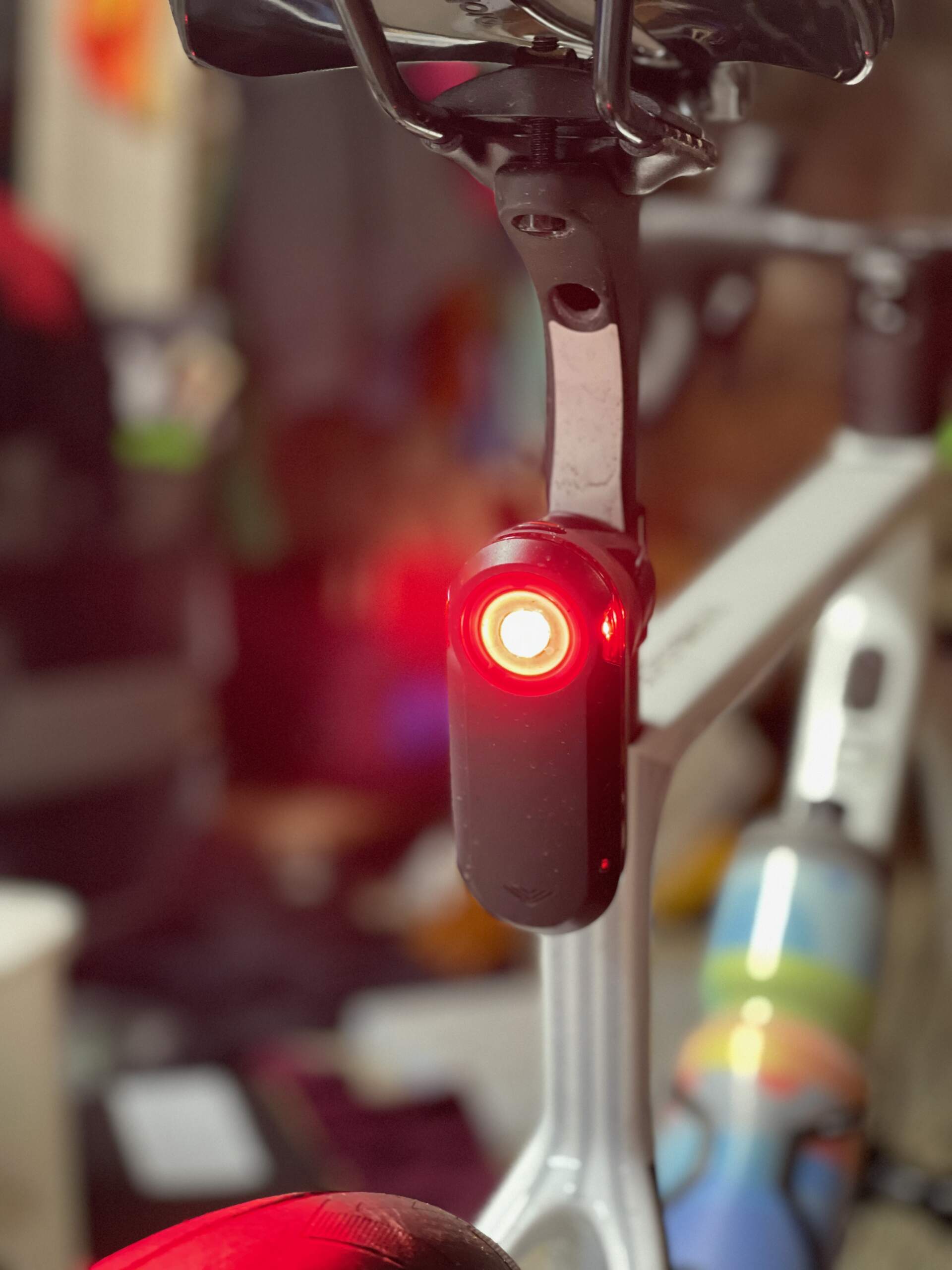
While most of the add-on Garmin products communicate on an open standard like ANT+ and function on other systems, none of them work as well as they do on Garmin’s own-branded devices. For example, on the Hammerhead Karoo 2 I can get data from the radar, but I haven’t found a way to change the Varia radar’s light flash modes. On the Edge 1030 Plus there’s a menu option that controls the flash modes—but see below for my thoughts on all the menu choices.
Grit and Flow
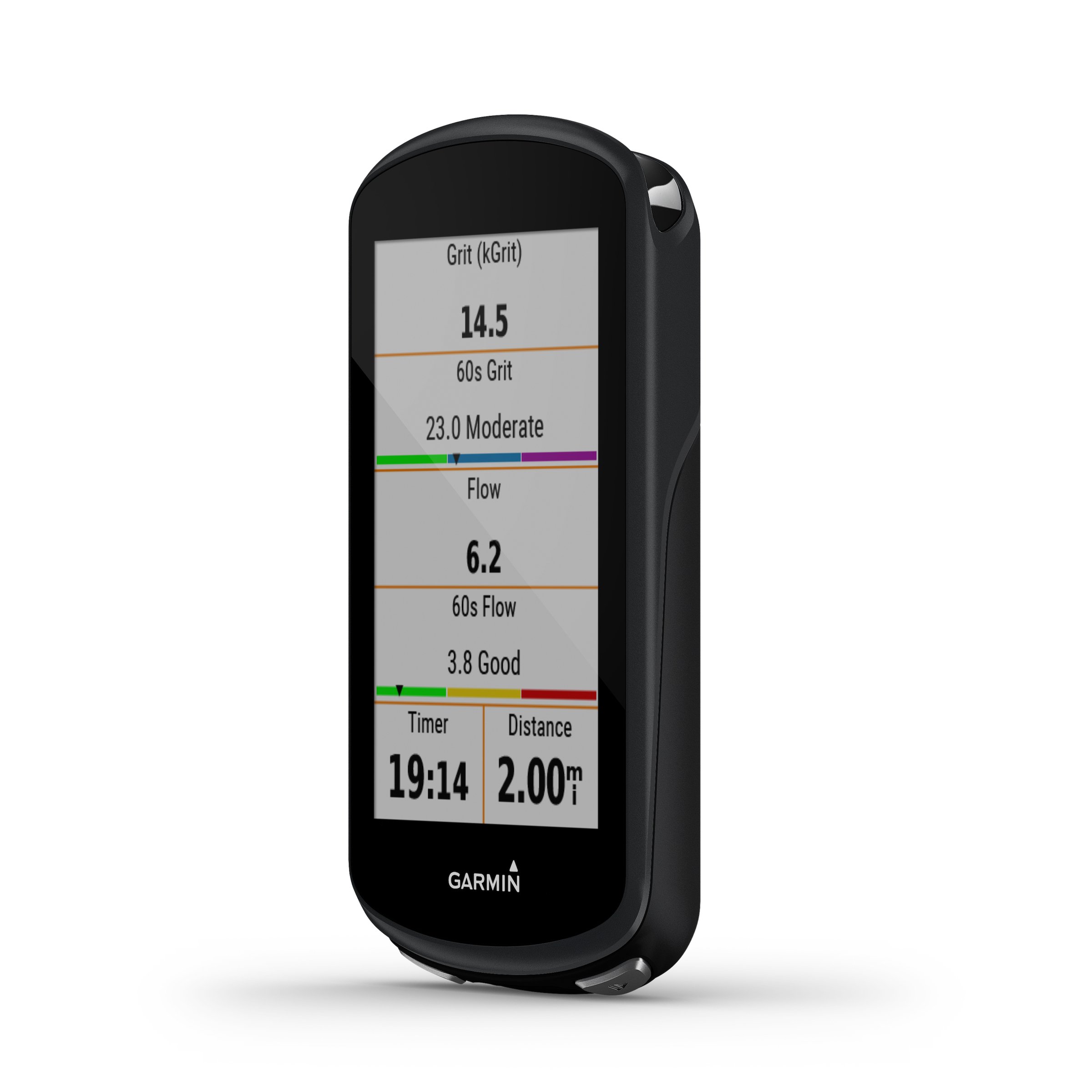
In other words, if you’ve already bought Garmin’s radar, Satellite communicator or power meter pedals, you’ll get a bit more oomph out of the integrated ecosystem Garmin has designed than you would with other bike computers.
Garmin has packed in as much usability to this device as possible. There are dozens of training-based features to the revamped mapping that uses local rider data to help pick the best routes. Serious athletes and pros can use the Edge 1030 Plus to design custom workouts and to dig deep into the metrics gained from a ride, all the way down to the Grit and Flow of your ride.
The mapping feels reinvigorated, and the connection to various sources of route data allows the Garmin to provide much better routing, and workout data can be directly uploaded to a number of training plans.
The UI
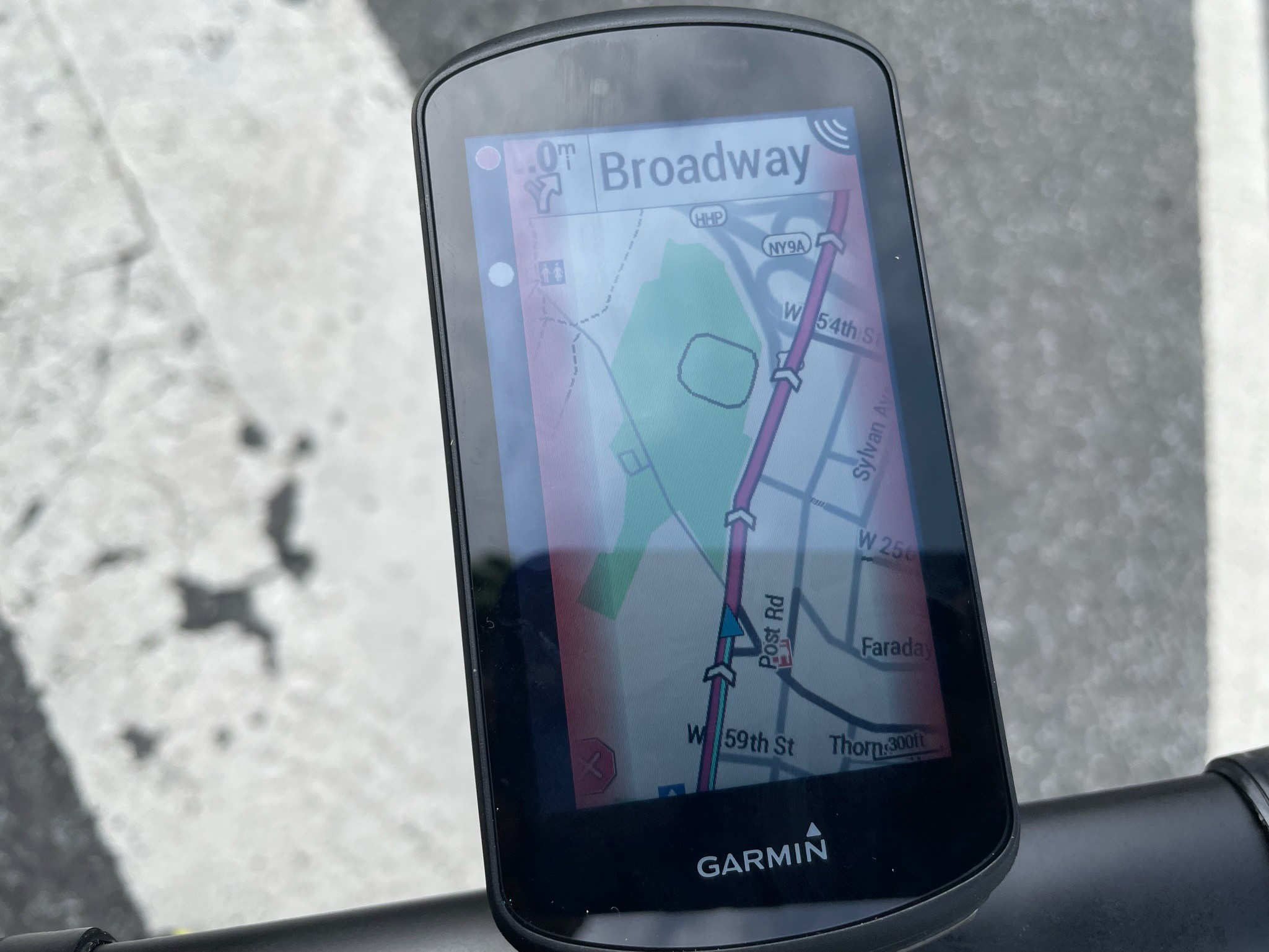
But the new Edge 1030 Plus still has a lot of the quirks of the previous models. As more features were added to the Edge devices, the user interface didn’t seem to have enough places to put them. As a result, it sometimes takes trips into multiple menus to find the setting you’re looking for, and other times you’ll need to rely on Garmin’s mobile app to change a setting.
At the same time though, the Garmin experience is so universal and so familiar to any current Garmin owner that they can pick up any of the company’s product lines and understand how to get around. Not all the features we’ll look at are unique to the Edge 1030 Plus, but since the Edge 1030 Plus is the newest member of the family, it represents the system as a whole. We also won’t be able to cover all the features in-depth in this review.
The Garmin Edge Bike Computer Line
Edge is Garmin’s bike-specific GPS device, and I’ve actually ridden with Garmin “bike” computers way before the Edge, strapping the hiking-specific eTrax GPS units to my bike.
The Garmin 1030 Plus is a completely different beast than those old, heavy, eTrax units, but in many ways, they haven’t changed a bit. Garmin devices are instantly familiar to anyone using another one of the company’s products, and the user interface has remained relatively consistent for the life of the Edge line. As the bike computers have gained more features, Garmin has modified the layout of menus and data fields, but in general, anyone that used a Garmin 10 years ago will be able to pick one up and get going right away. There’s a familiarity and comfort to using Garmin’s interface. As you’ll see, that familiar interface is both a blessing and a curse.
Garmin has recently been challenged by upstart bike computer companies that have responded to perceived weaknesses in both the interface and navigation of the Edge. Wahoo and Hammerhead have both taken on facets of Garmin’s user experience as their direct competitive advantage to the market leader, and those perceived weaknesses are core of their marketing campaigns. While this isn’t a head-to-head review, I did complete the Garmin Edge 1030 Plus review while simultaneously using the Hammerhead Karoo 2, and I’ll make some comparisons where applicable.
Hundreds of Riding Hours
After hundreds of hours with the Garmin Edge 1030 Plus and the Hammerhead Karoo 2—as well as my experiences with Wahoo—it turns out that all bike computers have their peculiarities, and picking one is often more about which evils you find necessary, and which you’re willing to accept. At the end of the day, Garmin’s maturity, as well as its familiarity may be its greatest strength. But make no mistake about it, other companies are vying for a slice of the GPS computer market pie that Garmin has alone been enjoying for decades.
If I Stay There Will Be Trouble If I Leave There Will Be Double
If you’re looking for the brawniest, brainiest bike computer Garmin has to offer, the 1030 Plus is the one to get, especially if you already own one of the smaller Edge units, like the 830 or 130, or the company’s running-specific watches.
However, if you’re looking for a new take on the bike computer, keep an eye on Hammerhead and the Karoo 2. We will have a full review of that unit soon, and while it’s different in almost every way, it’s not necessarily better in every way. The OS of the Karoo 2, which runs on top of Android is incredibly powerful. The screen on the Karoo 2 is beautiful. It is crisper and sharper than the Garmin 1030 Plus by far.
I have no doubt in my mind that the Garmin 1030 Plus and the apparent discontinuation of the 1030 model are a direct result of the pressure Hammerhead is putting on Garmin. One of Hammerhead’s claims of superiority is the strength of their navigation system and the power of their training features. The Edge 1030 Plus is essentially the best of the previous Edge product line, combined with upgrades to both training and navigation.
Hammerhead Karoo 2
It’s possible that Garmin would have created the Edge 1030 Plus in the absence of the competition from Wahoo and Hammerhead, but competition is a good thing, and now Garmin and Hammerhead will race to be the best choice for the top-end cyclist.
While it’s not fair to compare devices by price point, it’s important to note that the Hammerhead Karoo 2 is around $200 cheaper than the Garmin Edge 1030 Plus, which makes it a nice system for the money—albeit with some growing to do until it gets closer to the full array of features Garmin’s Edge provides.
You Take The Good, You Take The Bad
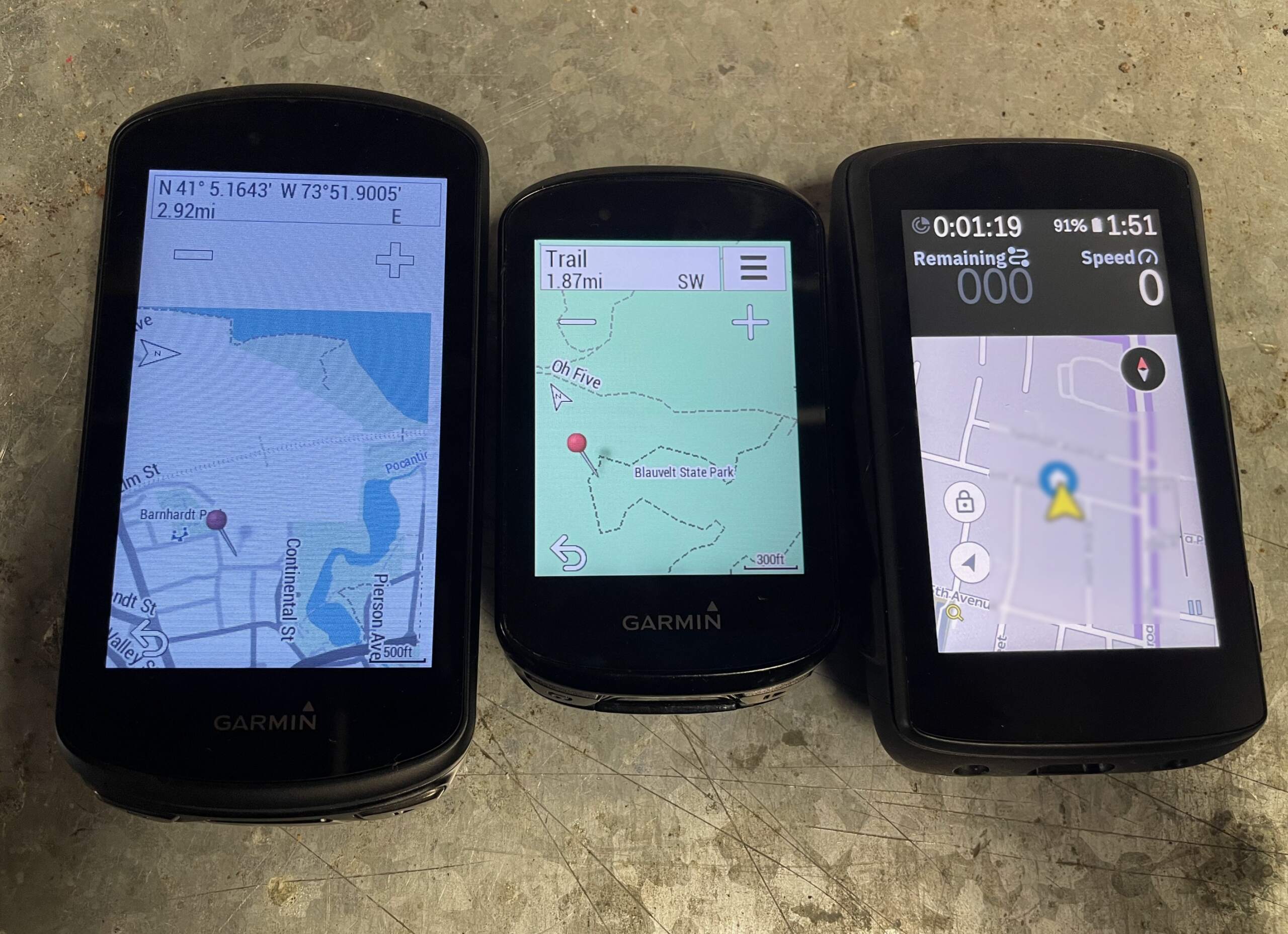
Even before the Karoo 2 came along with its crisp, beautiful smartphone-quality screen, the screen of the Garmin Edge was a bit underwhelming, with particularly lackluster colors and only relatively good contrast. I checked out the Garmin Edge 1030 Plus against the Karoo 2 and the Edge 830, and even the Edge 830 had a brighter, sharper display. At 60% brightness, my Edge 830 was as bright as the Edge 1030 Plus at 100%.
The low resolution of the Garmin screens means text and lines are pixelated and colors muted. If the Garmin Edge 130 Pro were to show up a the wedding of Nokia Flip Phone and Samsung Galaxy, you’ll easily be able to tell that the Edge 130 Pro is the cousin—albeit the more attractive cousin—of the Nokia Flip Phone, while the Karoo 2 is probably Samsung’s younger brother.
Flip Side
The flip side, pardon the pun, is that the display is incredibly easy to read in both low and bright light, and just sips at the battery of the Garmin 130 Plus, as long as you’re not using a lot of sensors such as radars, pedals, heart rate, etc. Even with a 24 hour claimed runtime, the Garmin 130 Plus only claims an eight-hour runtime at “high” and 12 hours a “low” use. I performed a ride test duplicating a route I had done the day before on the Hammerhead Karoo 2. After three hours of riding, I had used just under 60% of the battery power, although on another ride I finished 8 total hours (only six riding) with 40% to go.
It’s the constant communication between the Edge and the various sensors that are making the battery run down so quickly. My Edge 1030 Plus was connected to the Varia taillight radar, a cadence sensor, a wheel-based speed sensor, and a turn-by-turn route being navigated on the Map screen. There’s so much communication between those devices, and so much math being done to calculate the real-time data.
Power Hungry
Interestingly, the Karoo 2 did the shorter route with about 56%—about the same as the Garmin. With such a power-hungry high-resolution screen you’d wonder how the Karoo 2 kept power draw to the same general point, and the answer is processor power and operating system. The Karoo 2 has a mobile processor and the OS is Android. A smartphone operating system is designed to be as battery-conservative as possible, so it can have incredibly fancier screens and graphics than the Garmin yet still run for the same amount of time. Garmin, however, offers an add-on battery, which it a fantastic idea, and something I wish I had when I did multi-day rides.
Editor’s Note: I did a follow-up ride about a week later, a planned century that was cut short by the weather and ended up being about 86 miles. Since I was testing the Karoo 2, I had that instead of the Garmin. The Hammerhead was draining power incredibly quickly, so much so that I had to put it into power-saver mode at about 15 miles in, just to be able to finish the ride. I’m not sure why the first ride did so little power draining and the second one would have left me stranded without a computer, but in any case I’m sure the Garmin Edge 1030 Plus would have handled the eight-hour day that was both the riding and stopping we did, and still have power to spare.
Micro USB
Another small “gotcha” with Garmin is that the Edge series still uses micro USB for charging. That was fine when USB-C was new, but at this point, I only use a micro USB cable for my kindle, older mobile batteries that charged with those cables, and my Garmin devices. This means that on a ride I need to bring along cables just for my bike computer and radar.
Those issues aside, the Garmin Edge 1030 Plus is jam-packed with features. The Edge can be used as a bike alarm, it can send your live track information to selected contacts, it can detect a crash and send your location to your emergency contacts, it works with the Garmin satellite devices, can guide people on your ride back to you if you get lost, allows for messaging between people on a ride, and much more.
Garmin’s devices also connect with more third-party training and ride tools than any competitor, making it easier to bring in routes and training plans, and making it easier to share rides with your friends and teammates.
Hardcore Nerdcore
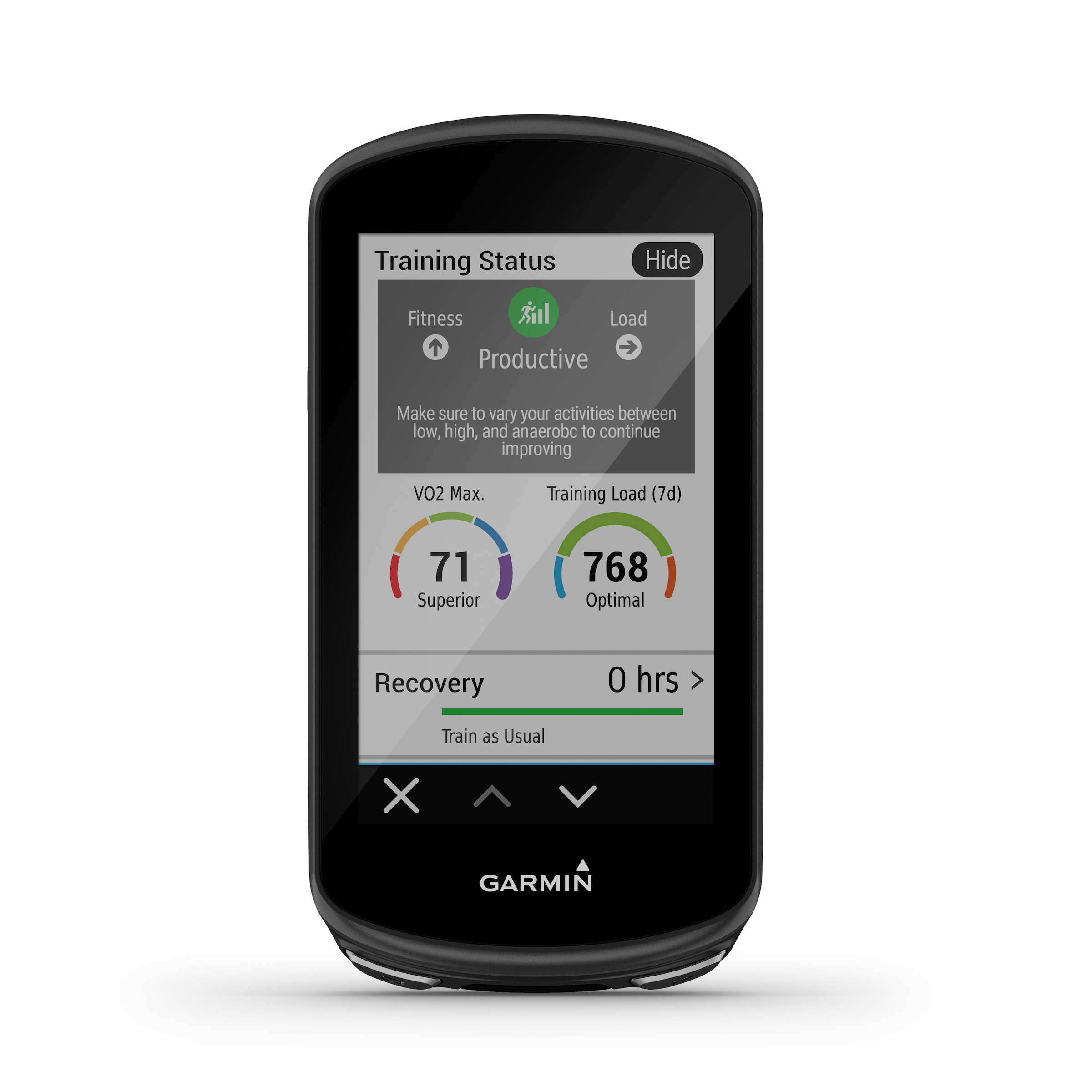
For cyclists that are training, there are now dozens of onboard tools that help maximize performance. Dynamic Performance Monitoring can track VO2 max, recovery time, and more. Training Status evaluates how “effectively” you’ve been training. You can sync training plans from TrainingPeaks or Training Road, and the device can suggest training plans.
The Edge 1030 Plus can even track your performance as you tweak the setup of your bike, giving riders metrics to determine if their setup has helped or hindered their performance, which for many users will be worth the price of admission.
(A more complete list of these training features can be found about halfway down Garmin’s product page.)
Navigation
At its core, Garmin is a mapping company. All of Garmin’s products—from bike computers to airplane navigation systems—rely on the company’s cartography. The devices are simply means of accessing that cartography and matching it up with GPS data.
Garmin’s navigation has always been a bit quirky. It will get you where you need to go, it will get you back from where you went, but it wouldn’t always do it with the most cycling-friendly routes. I’ve spent time on the shoulders of major roads instead of on parallel side roads that are more bike friendly, I’ve climbed the biggest hill in a town because that hill is the most direct route while a neighboring road would have been flat and only added half a mile.
Hammerhead has particularly latched onto this and marketing materials have pardon me, hammered on their mapping technology and the system’s excellent routing, which it does in fact have.
Editor’s Note: Based on more weeks of riding, we have found that what the Hammerhead does not have is a good way to change your destination during the ride. You can load a route into the Karoo 2, you can get navigated back onto the route on the Karoo 2 if you go off course.
What you cannot do with the Karoo 2, but is simple-as-pie on the Garmin Edge, is pick a brand new point to ride to while you’re out on your bike.
With the Garmin Edge, finding a new destination is as simple as entering an address, a cross street or picking from a list of Points of Interest. Since the local maps are already loaded onto the Edge, there’s no need to have an internet connection to find a new POI (Point of Interest). In fact, on one of our rides we decided we wanted to change our end point and ride to Battery Park in NYC. I simply put in the intersection of Battery Park and State Street.
Want to find a nearby coffee shop? No problem, simply navigate to the POI section on the Edge and look for one in the Food section. Need a bike store? Grocery store? Laundromat? You can find all of those on the Garmin Edge directly.
This simply isn’t possible on the Karoo 2. If one wants to pick a new destination, the choices are essentially to drop a pin on the map, or set your cell phone to hot spot mode, and use the web interface to download a new map to the device.
That means that any time you want to use the Karoo 2 to pick a new destination while riding, you’ll need to take your phone with you to do so. If your phone runs out of juice, then the only place you can go is wherever you can find to drop a pin on a map, or turn around and go back home.
This is such a big misstep that until I spoke with the Hammerhead PR team recently, I was certain I had been missing something simple. It’s plainly not acceptable for a device that boasts superior routing to also be so utterly lacking in finding places.
Now the benefit of relying on online mapping, as the Karoo 2 does, is that it keeps up with the myriad changes in intersections, road work, and business closings better than the pre-installed Garmin maps. I would, however, gladly trade the ability to navigate to a coffee shop that I find is closed when I get there than to not be able to navigate to it in the first place.
This alone makes the Garmin Edge 1030 Plus a better buy, and until the Karoo 2 comes up with a way to do new-route-planning on the fly, it’s a non-starter for me. Most of my rides are discovery rides (the “hey I wonder where that road goes” or “I’m really in the mood for a good pastry” type of rides) and not being able to find where I want to go is a problem.
You can add a SIM card to the Karoo 2, but the idea of adding a $65/month new data plan just so I can find my way to a specific address isn’t worth it, especially when I already have $1000 of phone gear with me.
Route Caching
This clearly was the impetus for Garmin to release the most current firmware update to the Edge 1030 Plus, which was primarily about navigation. The update brought improved course routing, automatic route caching, better visibility, and a popularity feature to show what roads are the most commonly ridden in an area. They also added directional arrows to routes and courses, which is something they’ve needed for a long time, and something that seems likely to have come about because of the competing systems.
The new maps worked well when testing on Cape Cod, where I rode with my friend Ross, whose family has a house there, and has been traveling the roads since childhood. On a 70 mile ride, the Edge 1030 Plus piloted us along many of the same roads that Ross would have picked for the ride, and in a few instances took us on shortcuts that eliminated sketchy sections of busy Route 6 along a scenic route that Ross said he wouldn’t have thought of doing.
I did find a lot of issues when importing routes from Strava, I think because it uses Open Maps, an open-source mapping platform that’s common for third-party tools to use, while Garmin uses its maps. Open Maps tends to have more up-to-date changes to road conditions than Garmin’s maps, thanks to the feedback of users, but I think when Open Maps and Garmin’s maps try to work together there is sometimes chaos.
Editor’s Note: The bottom line here is to be careful when importing from Strava, and to use Garmin’s tools whenever possible for route mapping.
Missing Bike Path
The biggest issue came when I tried to use a Strava route to cross our local bridge in suburban New York and ride the other side of the river down to New York City. The bridge, the Mario Cuomo opened several years ago but the bike path didn’t open until just after COVID started. That new bike path doesn’t seem to be reflected in the maps that were preloaded on the Edge, so my device told me to U-Turn repeatedly the whole halfway across the bridge, and after that just it gave up navigation.
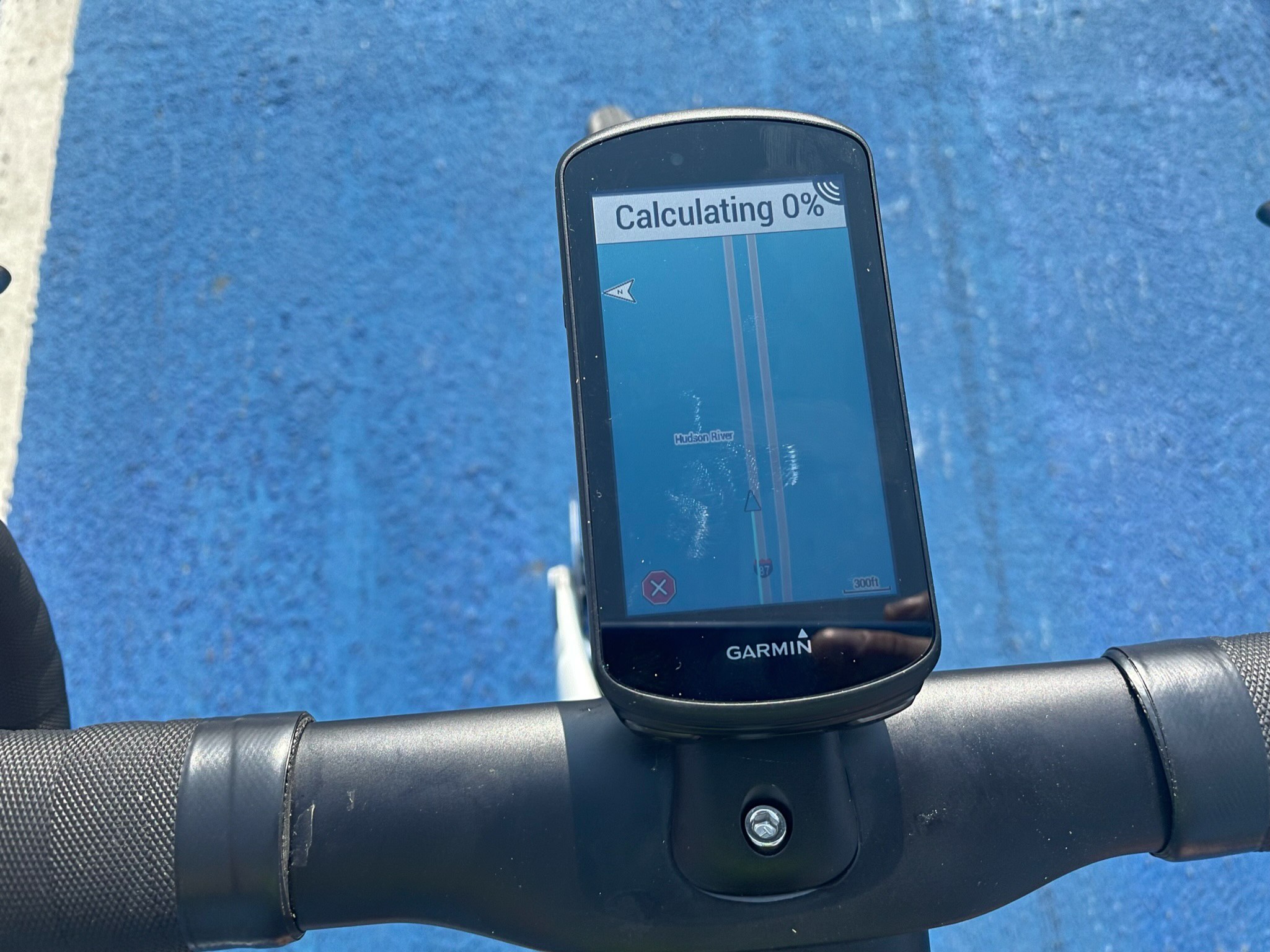
When I got to the other side of the river, I simply canceled the route I was on and picked the same endpoint using Garmin’s search, and had no real problems for the rest of the ride.
The Edge had a preference for streets over a rail-to-trail, so it kept trying to direct me off the South County Trailway for a block or two of local streets, which I just skipped. Sharing this feedback with Garmin, they suggested I switch my riding type in my Profile to Commuting or Touring. There’s a bug as of this writing where Touring isn’t a possible selection, but on rides on Cape Cod, the Commuting option picked bike trail over the road, which made for a nicer casual ride.
Editor’s note: After many conversations with Garmin’s product teams, it became apparent that the reason this lack-of-bridge-path issue occurred was the age of the default basemaps on the Edge.
When. device is manufactured, it gets loaded with the current software at the time of manufacturer. Obviously, a device sitting in a cargo container coming from the factory in China can’t update itself.
With the help of Garmin’s team, I calculated that the Edge went on sale just before the bike trail opened, by days. With the combination of transit time and ship times, the maps on the Garmin had to have been pre-loaded at least a month in advance. As far as the Edge was concerned there was no bike lane on the bridge because it had not yet opened.
Garmin told me that they sent out an email to all registered users to let them know of the map update to the devices that went out right around when the Edge 1030 Plus was released—but since I’m not a registered user, by instead a member of the press, I’m not on that list.
A nice feature would be for Garmin Connect to poll the Edge (or any other device) when they establish a handshake and notify a user if the maps are out of date. Even if I still have to use Garmin Express (see below) to load the maps, at least I’d have the same notification system I do for firmware updates.
Updating Maps
When I was doing the bulk of my testing of the Garmin Edge 1030 Plus on Cape Cod, I ran into a peculiar “gotcha” with updating my maps. Garmin’s PR team was nice enough to spend multiple emails working over my questions about navigation, and specifically what to do about the bridge bike path that existed IRL but didn’t exist on the Garmin.
The way to update a route on the Garmin is to download the newest version of the maps. This requires using a program called Garmin Express, an ancient-feeling app that simply downloads new base maps to your Garmin devices. Plug in the device, and if there’s a new version of the map you can download it in one click. (You can tell the app is older not just from the interface, but at how long it estimates download times. I have a FIOS Gigabit connection, and it estimated the download would take 9 hours 11 minutes, when it actually took under 10 minutes. It feels like it’s still estimating for dial-up connectivity.)
The “gotcha” I ran into is that I could not get this app working on my M1 MacBook Pro, and that’s the computer I had with me on my trip. I’m not sure if it was the cable I had with me, or the fact that the M1 Mac running the software in emulation mode wasn’t working (which is my suspicion since the software is so old to begin with), but I couldn’t update the map. I still had a map, and it worked fine on Cape Cod, but I couldn’t update it.
When I got back home to my Intel-based iMac it updated without any problems.
That said, with a Garmin Connect phone-based App and with the speed of WiFi transmission, there really should be a way Garmin can ditch the aging Garmin Express and update either via the Garmin Connect website or the Garmin Connect app, unifying the experience.
Getting To Know You
The setup of the Edge requires using both the cycling computer and also the Garmin Connect mobile app makes setup more confusing than it needs to be. I watched my friend Ross get stumped when setting up his Edge 830 for the first time.
The growth of sophistication of Garmin bike computers have left the menu system a tattered mess. Each new feature has added some new tool to a menu but there’s no logic to the navigation tree. In other words, where the iPhone has a single Settings icon with various settings branching off from that in a logical fashion, it feels like the Edge OS (whatever it’s called) just tacked new features on where they would fit.
There are still just a few buttons on the device, making a lot of feature and mode selection reliant on a touch screen interface that’s the same as previous Edge models—sometimes too sensitive and sometimes too insensitive. There’s a lot of swiping possible on the current Edge models, but I know people who didn’t realize there was swiping from the top until I showed them.
If you’re new to Garmin’s environment, take time to go through every single choice in the menu system to see what’s available before you get too far along with the unit. Even if you can’t remember exactly where a setting was, you’ll know that the setting you’re looking for at least exists.
Varia Radar
As an example, the Garmin Varia radar has several choices for how the passing car notification works. The default mode puts a yellow or red border on both sides of the display as a car passes. The border is incredibly intrusive, blocking some of the letters on both sides of the display. If I hadn’t done a deep dive through the menus I wouldn’t have known that you can change this setting so that there isn’t a border, change the alert tones (single, double, or off) and switch which side of the screen the display of passing cars is on.
Where is that setting? Well, it’s in the main menu under Sensors, then in the setting for the radar, and then a user has to click Sensor Details, then click on Alert Settings. One can also change the light behavior on the Varia radar, but that’s a setting under the Sensor Details for Lights, not Radar. Had I not gone down the menu tree for every single setting I’d never have known these choices are available.
Competitors have used this as a selling point of their systems, with both the computers from Wahoo and the does the setup is touted as being easier, and in the most recent update to the Karoo 2, the company introduced a new on-device product walkthrough and has announced plans to further enhance the familiarity with the interface through an overhaul of the setup process.
Plays Well With Others
The Edge also works with an impressive number of services, while the Karoo 2 currently works mostly with just Strava. Edge devices can connect to Strava, Trailforks, Relive, TrainingPeaks and TrainerRoad, and it’s simple to share a ride on social media. As soon as I finish a ride and the Edge 1030 Plus connects to the WiFi at my house, it uploads my ride to Strava. My route is shared with friends from the app Relieve, and from Strava before I even get my shoes off.
Due to the length of this piece, we’ll look separately at the group communication features of the Garmin Edge 1030 Plus. The ability to see where your riding partners are on a map, and to quickly send them messages without having to take out a smartphone are pretty impressive and are ahead of the competition. My friends and I have all set the Garmin to allow for live tracking of each other’s rides, yet we’ve never gotten this working.
Conclusion, Again
If you stuck around after the TLDR in the introduction, you’ll already know that the Garmin Edge 1030 Plus is an incredibly powerful bike computer. It is the best bike computer Garmin has ever made, and that makes it one of the best bike computers ever made.
Truth be told, the Garmin Edge 1030 Plus is already the best bike computer ever made—with more features and functionality than anything else on the market—thanks to decades of product design and development, a feature list that surpasses competitors, and the interconnection with other services, the Edge 1030 Plus is the most feature-rich, and the most capable bike computer on the market, period.
The Karoo 2 has surpassed the Garmin Edge 1030 Plus in some areas—most notably the display—but has not surpassed it in some critical areas, like navigation. That’s impressive for a startup that’s a few years old, but it’s not the end of the race. In our hands-on Hammerhead Karoo 2 we’ll talk about who that device is good for, where it excels and where it misses the mark. But the Edge 1030 Plus is a more rounded system.
Of course, this isn’t to say that it’s the right choice for every user. Wahoo makes compellingly small and functional devices, and Hammerhead’s Karoo 2 has a screen to die for, and increasingly sophisticated mapping and training, all at a lower price. Even Garmin’s less-sophisticated units are going to be a better choice for some than the Edge 1030 Plus, simply because not everyone needs a full cycling coach built into their bike computer. The Garmin 830, which I also use, is a wonderful no-nonsense, compact trainer for those that don’t need to condition themselves for a stage race or a critical.
Editor’s Note: Because it’s not possible currently with the Hammerhead Karoo 2 to change routes mid-ride without the use of a phone being used as a hotspot, the Karoo 2 simply can’t be used on rides where you’re planning to change your destination suddenly, or where you don’t want to carry your phone with you. That makes it suitable for local training rides, but currently I wouldn’t recommend taking the Karoo 2 on an adventure or touring ride—which is odd considering the birth of the Karoo 2 was on a cross-country ride where being able to navigate to local points of interest would have been pretty critical.
This makes the Karoo 2 great for training rides, since there are so many training tools available, but the Garmin Edge 1030 Plus also has access to training tools, and connects with more training services than does the Karoo 2.
What the Garmin Edge 1030 Plus has going for it is that the strengths of the device vastly outweigh the weaknesses of the device. If you want a bike computer with every bell-and-whistle that exists today, the Garmin Edge 1030 Plus is for you. The intrepid traveler that needs to be able to get reliably from point A to point B, will appreciate the Garmin Edge 1030 Plus. If you’re a hardcore racer or looking to improve your cycling with dynamic coaching and feedback, the Garmin Edge 1030 Plus is for you. And if you own or plan to own any of Garmin’s other products and want to get the most functionality out of those accessories, the Garmin Edge 1030 Plus is for you.
Tacx Trainer Addendum
After this article published, we had a conversation with Garmin’s media product managers specifically bout the Tacx indoor trainers, and wanted to mention the interoperability of the trainers with Garmin, and with other head units.
Any of the company’s smart trainers (for example the NEO and Flux lines) will connect with Garmin head units. The company mentioned that trainers like the NEO 2T will provide indoor ride active on the head unit (and since it’s ANT+ FE-c will show that data on any other compatible computer) but for Garmin users there are a few great perks.
With the Garmin Edge connected to the trainer, a rider can follow a course from a previous ride. Simply use that course with the trainer and it will simulate the elevation changes from the original live GPS data. Since you can load any course onto the Garmin, you could spend your winter climbing Ventoux or doing a time trail from the Giro.
You can also follow any previously recorded routes you’ve done. Have a hill climb you particularly like? Let the Tacx trainers simulate the resistance of the course.
Resistance and power targets can also be changed right from the Garmin Edge, which provides a lot of flexibility and realism to a ride.
After the acquisition of Tacx, Garmin integrated the original Tacx apps with Garmin Connect, allowing all indoor rides from the Tacx app to sync to Garmin connect.

…
We're riding townies, adventure, and mountain bikes. Find recommendations on our store page. As Amazon Associates we earn from qualifying purchases.